Sulfur Isotope Analysis to Examine the Provenance of Cinnabar Used in Wall Paintings in the Roman domus Avinyó (Barcelona)
Abstract
1. Introduction
1.1. History of Use and Preparation of Cinnabar in Antiquity
1.2. Cinnabar Mines in Spain: A History of Use
2. Sampling and Analytical Method
2.1. The Site, the Sampled Contexts, and the Sampling of Wall Paintings
2.2. Analytical Routine and Measurements
3. Analytical Results and Discussion
4. Conclusions and Further Considerations
Author Contributions
Funding
Institutional Review Board Statement
Informed Consent Statement
Data Availability Statement
Acknowledgments
Conflicts of Interest
References
- Isidoro de Sevilla, I. Etimologías II, 2nd ed.; Reta, J.O., Marcos Casquero, M.A., Católica, S.A., Eds.; Biblioteca de Autores Cristianos, 434; Madrid Publicación Católica: Madrid, Spain, 1983. [Google Scholar]
- Vitruvio Polion, M. Los Diez Libros de Arquitectura, 2nd ed.; Ortiz, J., Rodríguez Ruíz, S.D., Eds.; Ediciones AKAL: Madrid, Spain, 1992. [Google Scholar]
- Abad-Casal, L. La pintura Romana en España. In 1R coloquio de Pintura Mural Romana en España: Actas del Coloquio Organizado por la Asociación de Pintura Mural Romana en Hispania; Jiménez Salvador, J.L., Ed.; Ministerio de Cultura, Generalitat Valenciana; Departament de Prehistòria i Arqueologia de la Universitat de València: València, Spain, 1992; pp. 13–24. [Google Scholar]
- Augusti, S. I Colouri Pompeiani, 2nd ed.; De Luca Editore: Roma, Italy, 1967. [Google Scholar]
- Barbet, A.; Delmare, F.; Monier, F.; Vindry, G.; Wallet, M. Les peintures romaines de Lero au Musée de la Mer: Dans l’Ill Sainte-Marguerite (Iles de Lérins). Revue du Louvre Études 1999, 3, 37–46. [Google Scholar]
- Colombo, L. I Colouri Degli Antichi; Nardini Editor: Fiesole, Italy, 1995. [Google Scholar]
- Secundi, P. Naturalis Historia, 2nd ed.; Russos, T., Levidakis, A., Eds.; AΓΡA: Athens, Greece, 1998. [Google Scholar]
- Tsantini, E.; Takeshi, M.; Takahashi., K.; Cau, M.A. Analysis of sulphur isotopes to identify the origin of cinnabar in the Roman wall paintings from Badalona (Spain). J. Arch. Sci. Rep. 2018, 18, 300–307. [Google Scholar] [CrossRef]
- Martín-Gil, F.J.; Delibes-de-Castro, G.; Zapatero-Magdaleno, P.; Sarabia-errero, F.J. The first known use of vermillion. Experientia 1995, 51, 759–761. [Google Scholar] [CrossRef] [PubMed]
- Mazzocchin, G.A.; Agnoli, F.; Mazzocchin, S.; Colpo, I. Analysis of pigments from Roman wall paintings found in Vicenza. Talanta 2003, 61, 565–572. [Google Scholar] [CrossRef]
- Spangenberg, J.E.; Lavric1y, J.V.; Meisser, N.; Serneels, V. Sulfur isotope analysis of cinnabar from Roman wall paintings by elemental analysis/isotope ratio mass spectrometry—Tracking the origin of archaeological red pigments and their authenticity. Rapid Commun. Mass Spectrom. 2010, 24, 2812–2816. [Google Scholar] [CrossRef] [PubMed]
- Elert, K.; Cardell, C. Weathering behavior of cinnabar-based tempera paints upon natural and accelerated aging. Spectrochim. Acta Part A Mol. Biomol. Spectrosc. 2019, 216, 236–248. [Google Scholar] [CrossRef]
- Schmitt, A.K.; Martin, D.; Erkan, A.; Erdal, Ş.; Lovera, O.M. Identifying the Volcanic Eruption Depicted in a Neolithic Painting at Çatalhöyük, Central Anatolia, Turkey. PLoS ONE 2014, 9, e0084711. [Google Scholar] [CrossRef]
- Huarto-Pérez, V. Informe sobre las Excavaciones en la Pijotilla (Badajoz). Extremad. Arqueol. 1988, 1, 35–54. [Google Scholar]
- Pavón-Soldevila, I.; Rodríguez-Díaz, A.; Enríque-Navascués, J.J.; Duque-Espino, D.M. La investigación en Extremadura prehistórica los últimos 25 años. Norba. Rev. Hist. 2009, 22, 31–55. [Google Scholar]
- Saupé, F. Geology of the Almadén Mercury Deposits, Province of Ciudad Real, Spain. Econ. Geol. 1990, 85, 482–510. [Google Scholar] [CrossRef]
- Saupé, F.; Arnold, M. Sulphur isotope geochemistry of the ores and country rocks at Almadén mercury deposits, Ciudad Real, Spain. Geochim. Cosmochim. Acta 1992, 56, 3765–3780. [Google Scholar] [CrossRef]
- Calderón, S. Los Minerales de España; Tomo, I., Ed.; Imorenta de Eduardo Arias: Madrid, Spain, 1910. [Google Scholar]
- Jébrak, M.; Higueras, P.; Marcooux, É.; Lorenzos, S. Geology and geochemistry of high-grade, volcanic rock-hosted, mercury mineralization in the Nuevo Entredicho deposit, Almadén district, Spain. Miner. Depos. 2002, 37, 421–432. [Google Scholar] [CrossRef]
- Hunt-Ortiz, M.A. Prehistoric Mining and Metallurgy in South West of the Iberian Peninsula; BAR International Series 1188; Arqueopress: Oxfrod, UK, 2003. [Google Scholar]
- Hernández, A.; Jébrak, M.; Higueras, P.; Oyarzun, R.; Morata, D.; Munhá, J. The Almadén mercury mining district, Spain. Miner. Depos. 1999, 34, 539–548. [Google Scholar] [CrossRef]
- García-Gómez, M.; Caballero-Klink, D.J.; Boffetta, P.; Español, S.; Sällsten, G.; Gómez-Quintana, J. Exposure to mercury in the mine of Almadén. Occup. Environ. Med. 2007, 64, 389–395. [Google Scholar] [CrossRef] [PubMed]
- IGME. Mapa Metalogénico de la Provincia de Badajoz; Escala 1:200.000; Instituto Geológico y Minero de España y Dirección General de Ordenación Industrial, Energía y Minas: Junta de Extremadura, Spain, 2006.
- Higueras, P.L.; Munhá, J.; Oyarzun, R.; Tassinari, G.I.; Ruiz, R. First lead isotopic data for cinnabar in the Almadén district (Spain): Implications for the genesis of the mercury deposits. Geogazeta 2005, 37, 67–70. [Google Scholar] [CrossRef]
- Higueras, P.L.; Oyarzun, R.; Munha, J.; Morata, D. The Almaden Mercury Metallogenic Cluster (Ciudad Real, Spain): Alkaline Magmatism Leading to Mineralization Processes at an Intraplate Tectonic Setting. Rev. Soc. Geológica España 2000, 13, 105–119. [Google Scholar]
- Hall, C.M.; Higueras, P.L.; Kesler, S.E.; Lunar, R.; Dong, H.; Halliday, A.N. Dating of alteration episodes related to mercury mineralization in the Almadén district, Spain. Earth Planet. Sci. Lett. 1997, 148, 287–298. [Google Scholar] [CrossRef]
- Calvo, F.A.; Guilemany, J.M.; Gómez Salazar, J.M. Estudios Sobre la Estructura y Consideraciones sobre la Génesis de las Menas de Mercurio: VI Yacimiento de Usagre (Badajoz). Rev. Real Acad. Cienc. Exactas Físicas Nat. 1985, 78, 267–284. [Google Scholar]
- Ortega Girones, E.; Hernández Sobrino, A. The mercury deposits of the Almadén syncline, Spain. Chron. Rech. Min. 1992, 506, 3–24. [Google Scholar]
- Rodríguez-Terente, L.M.; Luque-Cabal, C.; Gutiérrez-Clavero, M. Los registros mineros para sustancias metálicas en Asturias. Trab. Geol. Univ. Oviedo 2006, 26, 19–55. [Google Scholar]
- Barbanson, L.; Saulas, D.; Touray, J.C. Les blendes mercurifères de la región de Cabezón de la Sal (Santander, España). Bull. Miner. 1985, 108, 483–486. [Google Scholar] [CrossRef]
- Loredo, J.; Luque, C.; García-Iglesias, J. Conditions of formation of mercury deposits from the Cantabrian Zone Spain. Bull. Minéral. 1988, 111, 393–400. [Google Scholar] [CrossRef]
- Luque, C.; Garcia, J.; García, P. Características Geoquimicas de los Cinabrios de la Cordillera Cantábrica (NW de España): Utilidad en prospección. Trab. Geol. Univ. Oviedo 1989, 18, 1–11. [Google Scholar]
- Neira-Campos, A.; Alonso-Herrero, E.; Matías-Rodríguez, R.; Fuertes-Prieto, N.; Pérez-Ortíz, L.; San Román-Fernándes, F. La más antigua minería metálica en tierras de León. In El hallazgo leonés de Valdevimbre y los depósitos del Bronce Final Atlántico en la Península Ibérica; Junta de Castilla y León, Consejería de Cultura y Turismo, Diputación de León, Instituo Leonés de Cultura: León, Spain, 2007; pp. 220–223. [Google Scholar]
- Tritlla, J.; Cardellach, E. BaHg deposits in the Espadán ranges (Iberian Chain, Eastern Spain): An example of Cretaceous fluid circulation and Alpine overprinting. J. Geochem. Explor. 2003, 78–79, 579–584. [Google Scholar] [CrossRef]
- MUHBA. El domus Avinyó; Barcelona Inspira, Ajuntament de Barcelona: Barcelona, Spain, 2015. [Google Scholar]
- Minami, T.; Hatanaka, K.; Motizuki, Y.; Nakai, Y.; Takahashi, K. A method of collecting trace amounts of vermilion from artifacts for source estimation by sulfur isotope (δ34S) analysis: Use of sulfur-free adhesive tape to minimize damage to the artifact body during sampling. J. Arch. Sci. Rep. 2018, 28, 102027. [Google Scholar] [CrossRef]
- Kawano, M.; Tokuda, M.; Imazu, S.; Minami, T. Determination of original mine of vermilion collected from ancient burial mounds in Japan using an improved sulphur isotope analytical method for small amounts of vermilion. J. Appl. Laser Sect. 2014, 1, 37–40. [Google Scholar]
- Minami, T.; Imai, A.; Bunno, M.; Kawakami, K.; Imazu, S. Using sulfur isotopes to determine the sources of vermilion in ancient burial mounds in Japan. Geoarchaeology 2005, 20, 79–84. [Google Scholar] [CrossRef]
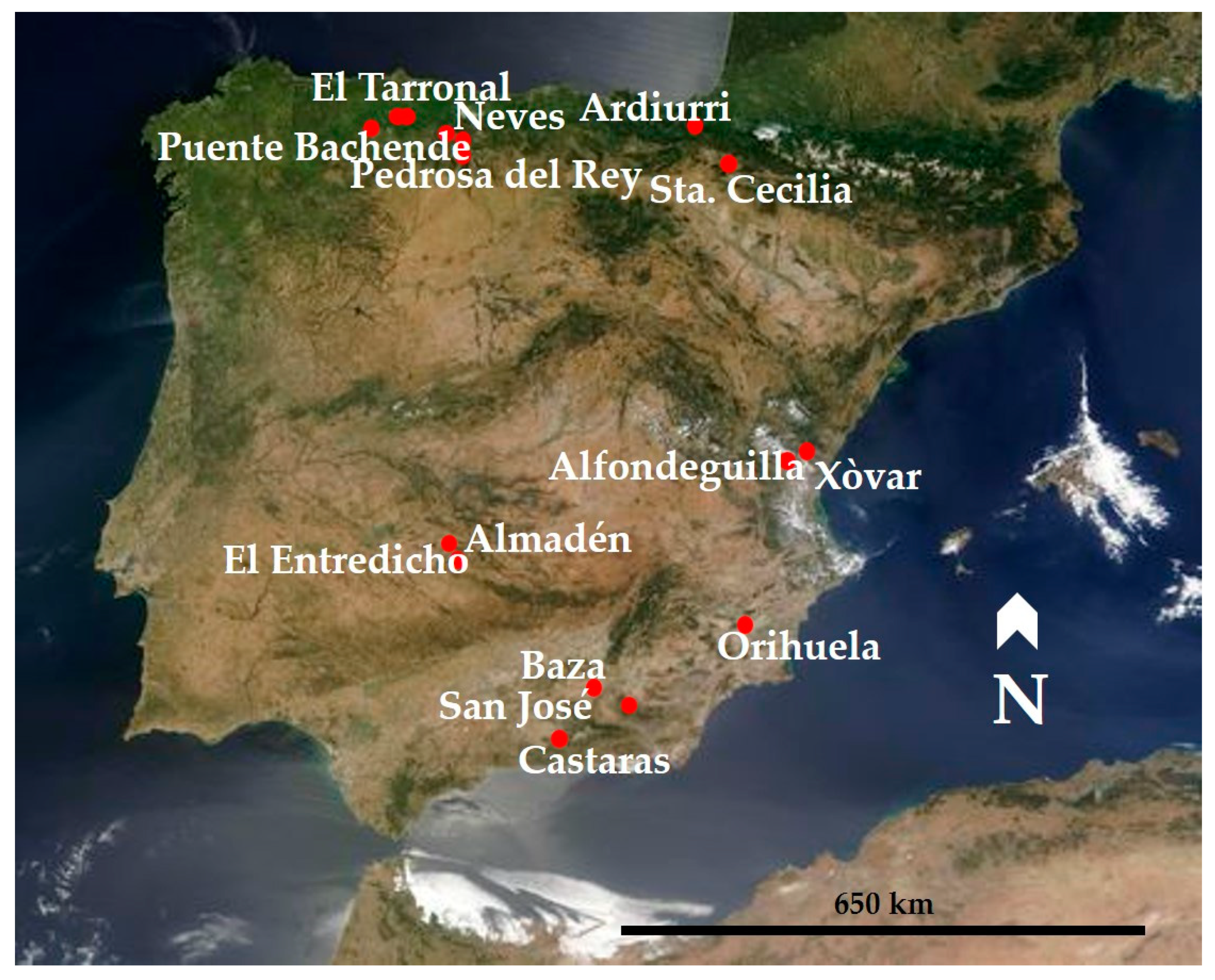
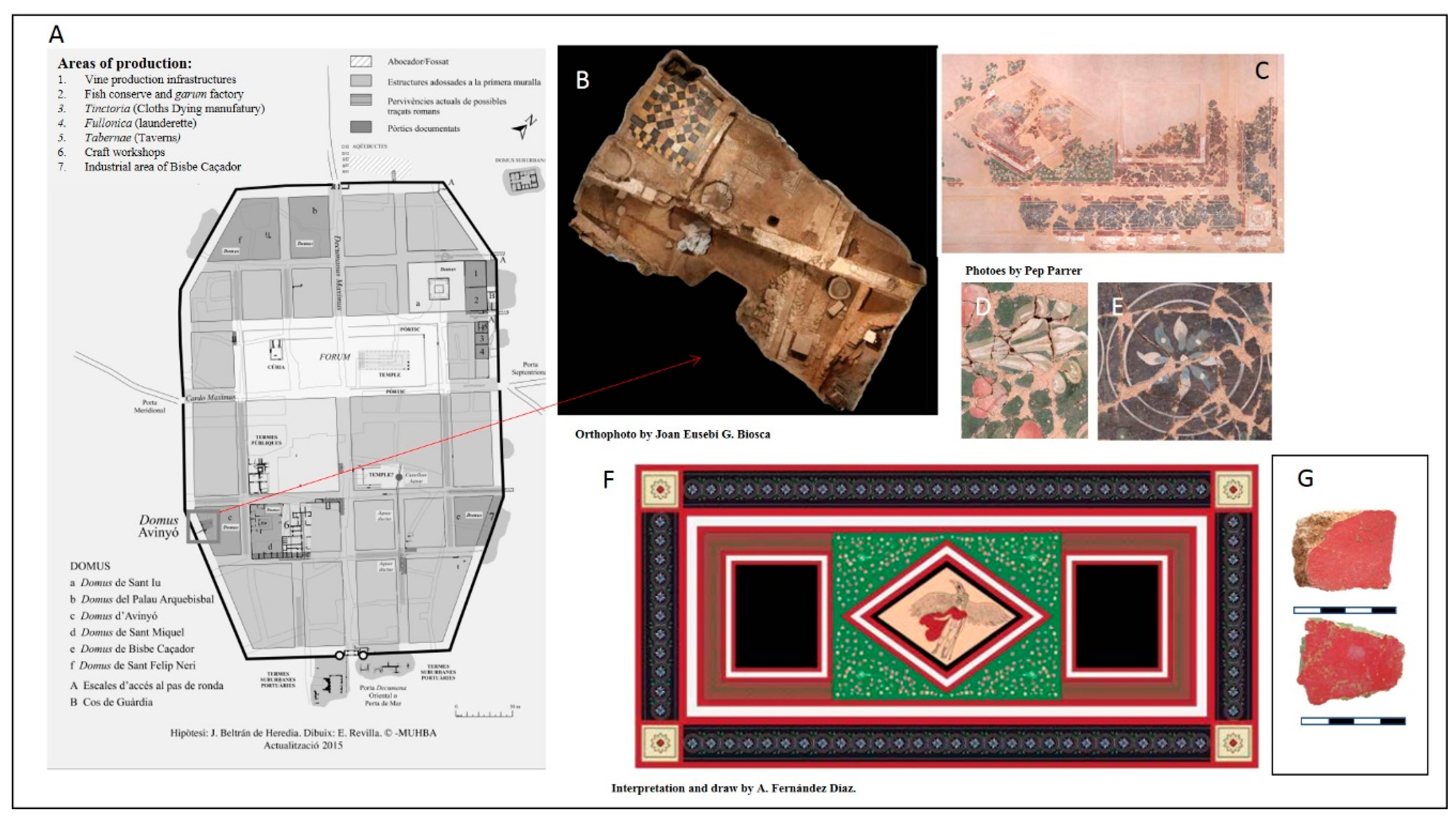
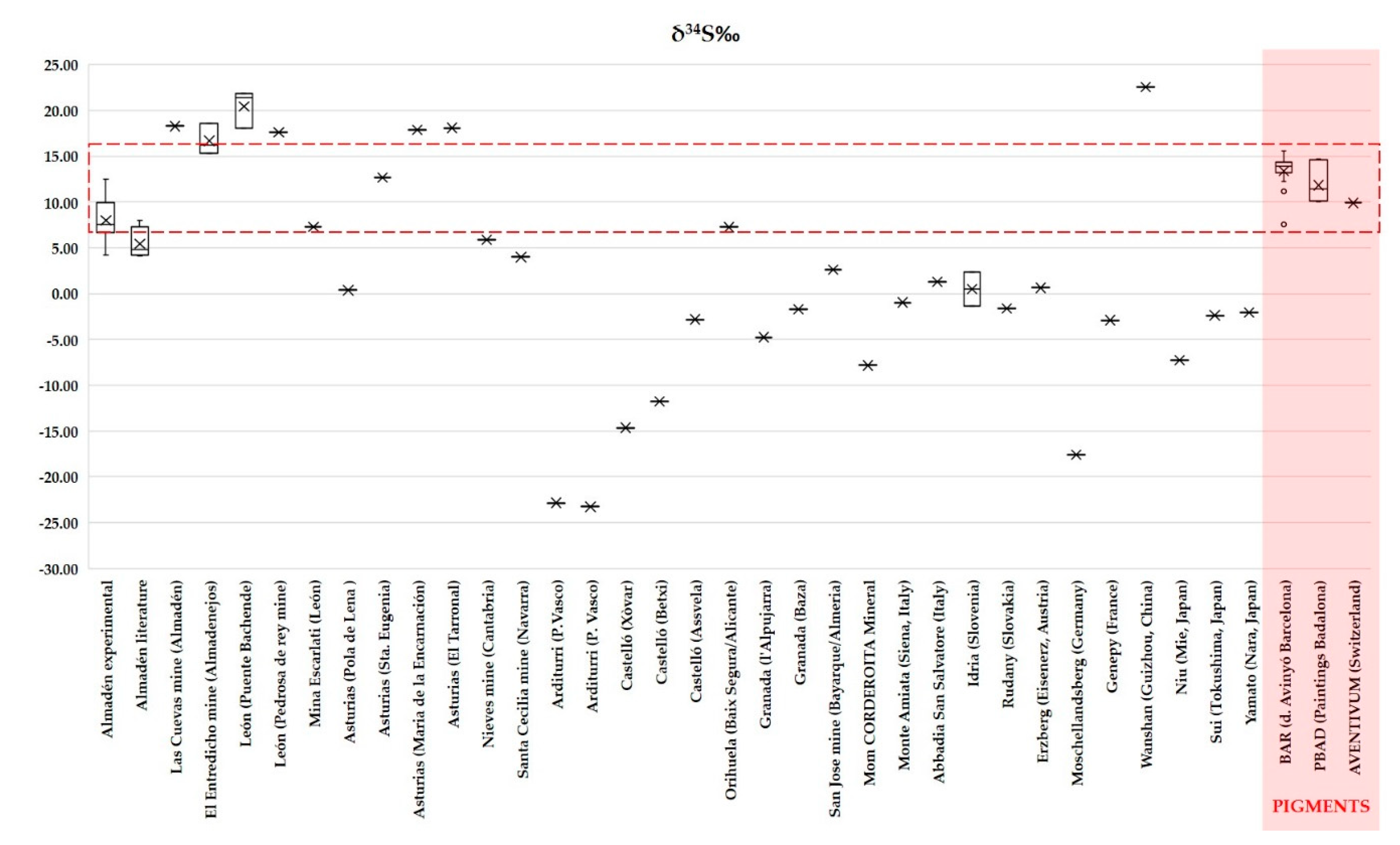
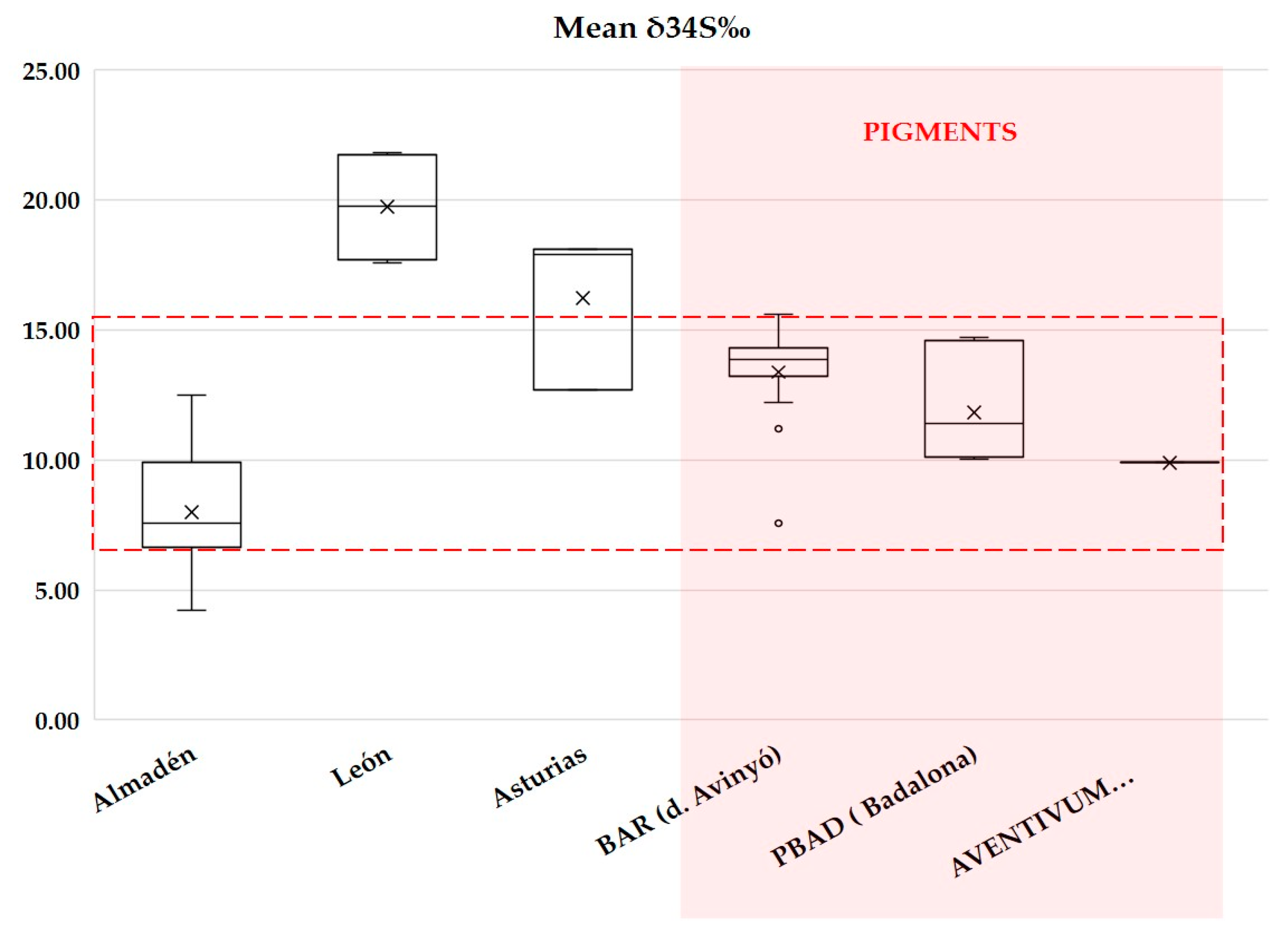
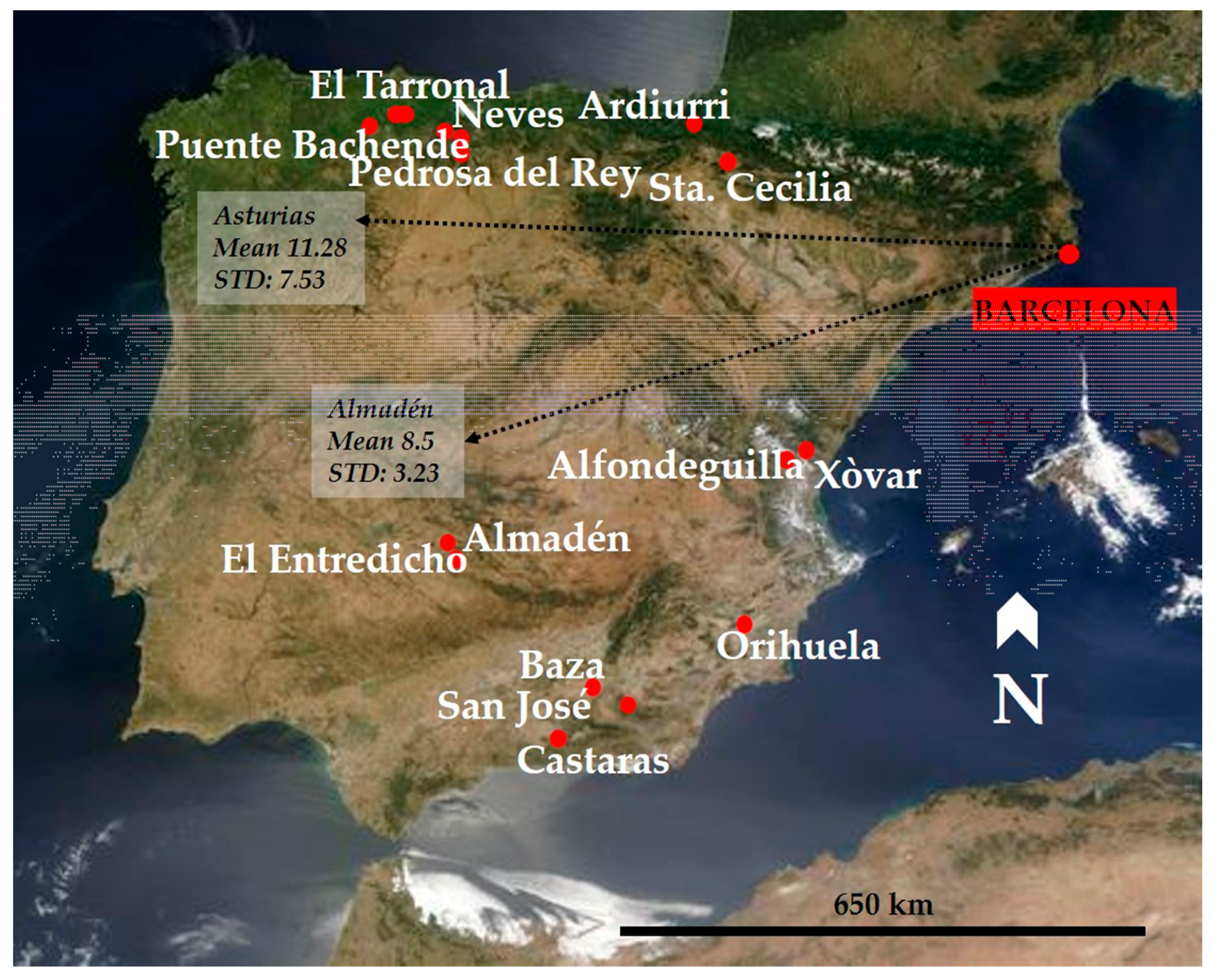
| Type of Sample | Samples | S Isotopes | Mean Isotoìc Value | SD |
|---|---|---|---|---|
| Cinnabar mineral | Almaden (Ciudad Real/Castilla a la Mancha) | 5.04 | ||
| Cinnabar mineral | Almaden (Ciudad Real/Castilla a la Mancha) | 8.17 | ||
| Cinnabar mineral | Almaden (Ciudad Real/Castilla a la Mancha) | 6.741 | ||
| Cinnabar mineral | Almaden (Ciudad Real/Castilla a la Mancha) | 6.8 | ||
| Cinnabar mineral | Almaden (Ciudad Real/Castilla a la Mancha) | 7.34 | ||
| Cinnabar mineral | Almaden (Ciudad Real/Castilla a la Mancha) | 4.23 | ||
| Cinnabar mineral | Almaden (Ciudad Real/Castilla a la Mancha) | 6.37 | ||
| Cinnabar mineral | Almaden (Ciudad Real/Castilla a la Mancha) | 9.61 | ||
| Cinnabar mineral | Almaden (Ciudad Real/Castilla a la Mancha) | 11.15 | ||
| Cinnabar mineral | Almaden (Ciudad Real/Castilla a la Mancha) | 10.77 | 8.51 | 3.23 |
| Cinnabar mineral | Almaden (Ciudad Real/Castilla a la Mancha) | 9.62 | ||
| Cinnabar mineral | Almaden (Ciudad Real/Castilla a la Mancha) | 12.5 | ||
| Cinnabar mineral | Almaden (Ciudad Real/Castilla a la Mancha) | 6.855 | ||
| Cinnabar mineral | Almaden (Ciudad Real/Castilla a la Mancha) | 7.61 | ||
| Cinnabar mineral | Almaden (Ciudad Real/Castilla a la Mancha) | 8.365 | ||
| Cinnabar mineral | Almaden (Ciudad Real/Castilla a la Mancha) | 7.51 | ||
| Cinnabar mineral | Almaden S5 (Ciudad Real/Castilla a la Mancha) | 11.03 | ||
| Cinnabar mineral | Almaden (Ciudad Real/Castilla a la Mancha) | 4.22 | ||
| Cinnabar mineral | Almadén (Ciudad Real/Castilla a la Mancha) | 8.06 | ||
| Cinnabar mineral | Las Cuevas mine (Ciudad Real/Castilla a la Mancha) | 18.3 | ||
| Cinnabar mineral | El Entredicho mine (Almadenejos/Castilla a la Mancha) | 18.6 | ||
| Cinnabar mineral | El Entredicho mine (Almadenejos/Castilla a la Mancha) | 15.3 | 16.7 | 1.71 |
| Cinnabar mineral | El Entredicho mine (Almadenejos/Castilla a la Mancha) | 16.2 | ||
| Cinnabar mineral | Puente Bachende Mine (Riaño/León) | 21.43 | ||
| Cinnabar mineral | Puente Bachende Mine (Riaño/León) | 21.84 | ||
| Cinnabar mineral | Puente Bachende Mine (Riaño/León) | 18.10 | 17.25 | 5.89 |
| Cinnabar mineral | Pedrosa de rey mine (Boca de Huérfano/ León) | 17.6 | ||
| Cinnabar mineral | Mina Escarlati (Puerto de las Señales, León)) | 7.29 | ||
| Cinnabar mineral | Pola de Lena (Pola de Lena/Asturias) | 0.39 | ||
| Cinnabar mineral | Eugenia mine (Pola Llena/Asturias) | 12.7 | 12.27 | 8.31 |
| Cinnabar mineral | Maria de la Encarnación mine (Somiedo/Asturias) | 17.9 | ||
| Cinnabar mineral | El Tarronal mine (La Peña/Asturias) | 18.1 | ||
| Cinnabar mineral | Nieves mine (Torrelavega/Cantabria) | 5.88 | ||
| Cinnabar mineral | Santa Cecilia mine (Arrive/Navarra) | 4.0 | ||
| Cinnabar mineral | Arditurri (Ergoien/Gipuzkoa/P.Vasco) | −22.84 | −23.06 | 0.31 |
| Cinnabar mineral | Arditurri (Ergoien/Gipuzkoa/P.Vasco) | −23.27 | ||
| Cinnabar mineral | Xòvar (l’Alt Palància/Castelló) | −14.65 | ||
| Cinnabar mineral | Betxi (Plana Baixa/Castelló) | −11.76 | −9.74 | 6.17 |
| Cinnabar mineral | Assvela (L’Alt Palàcia/Castelló) | −2.81 | ||
| Cinnabar mineral | Orihuela (Baix Segura/Alicante) | 7.27 | 7.27 | |
| Cinnabar mineral | Castaras (l’Alpujarra/Granada) | −4.77 | −3.24 | 2.16 |
| Cinnabar mineral | Baza (Baza/Granada) | −1.71 | ||
| Cinnabar mineral | San Jose mine (Bayarque/Almeria) | 2.6 | ||
| Cinnabar mineral | Mom CORDEROITA Mineral | −7.82 | ||
| Pigments | BAR1a | 15.59 | ||
| Pigments | BAR2a | 12.22 | ||
| Pigments | BAR3a | 13.98 | ||
| Pigments | BAR4a | 11.2 | ||
| Pigments | BAR1d | 14.5 | ||
| Pigments | BAR2d | 13.91 | 13.39 | 1.95 |
| Pigments | BAR3d | 13.24 | ||
| Pigments | BAR4d | 13.32 | ||
| Pigments | BAR5d | 13.83 | ||
| Pigments | BAR1e | 13.71 | ||
| Pigments | BAR2e | 14.25 | ||
| Pigments | BAR3e | 14.33 | ||
| Pigments | BAR4e | 15.38 | ||
| Pigments | BAR5e | 13.88 | ||
| Pigments | BAR1M | 7.56 | ||
| Pigments | PBAD13 | 14.7 | ||
| Pigments | PBAD13 | 10.1 | ||
| Pigments | PBAD13 | 11.4 | ||
| Pigments | PBAD36 | 10.02 | 11.84 | 2.01 |
| Pigments | PBAD36 | 11.6 | ||
| Pigments | PBAD36 | 10.45 | ||
| Pigments | PBAD46 | 14.6 | ||
| Geological sample/cinnabar ore | Wanshan (Guizhou, China) | - | 22.58 | 3.62 |
| Geological sample/cinnabar ore | Niu (Mie, Japan) | - | −7.26 | 1.85 |
| Geological sample/cinnabar ore | Sui (Tokushima, Japan) | - | −2.38 | 1.44 |
| Geological sample/cinnabar ore | Yamato (Nara, Japan) | - | −2.05 | 1.62 |
| Geological sample/cinnabar ore | Monte Amiata (Siena, Italy) | - | −0.97 | 0.51 |
| Geological sample/cinnabar ore | Erzberg (Eisenerz, Austria) | - | 0.65 | 3.47 |
| Geological sample/cinnabar ore | Idria (Slovenia) | - | −1.33 | 0.5 |
| Geological sample/cinnabar ore | Rudany (Slovakia) | - | −1.6 | 0.16 |
| Pigments (Spangenberg et al., 2010) | Aventicum (Avenches, Vaud, Switzerland) | 10.9–8.7 | 9.9 | 0.7 |
| Cinnabar mineral (Spangenberg et al., 2010) | Almaden (Spain) | 8.9–(–0.5) | 4.3 | 3.5 |
| Cinnabar mineral (Spangenberg et al., 2010) | Moschellandsberg (Germany) | (−19.6)–(−15.6) | −17.6 | 2.5 |
| Cinnabar mineral (Spangenberg et al., 2010) | Genepy (France) | (−2.2)–3.5 | −2.9 | 0.9 |
| Cinnabar mineral (Higueras et al., 2000) | Almaden (Spain) | 9.00–(−1.6) | 5.3 | 7.4 |
| Cinnabar mineral (Sauper and Arnold 1992) | Almaden (Spain) | 8.1–0.2 | 4.15 | 6.1 |
| Cinnabar mineral (García Gomez, et al., 2007) | Almaden (Spain) | 8 | 8 | 0 |
| Cinnabar mineral | Abbadia San Salvatore (Italy) | 2–0.6 | 1.3 | 2.6 |
| Cinnabar mineral | Idria (Slovenia) | 3.2–1.5 | 2.35 | 1.7 |
Publisher’s Note: MDPI stays neutral with regard to jurisdictional claims in published maps and institutional affiliations. |
© 2020 by the authors. Licensee MDPI, Basel, Switzerland. This article is an open access article distributed under the terms and conditions of the Creative Commons Attribution (CC BY) license (http://creativecommons.org/licenses/by/4.0/).
Share and Cite
Tsantini, E.; Minami, T.; Cau Ontiveros, M.Á.; Takahashi, K.; Melgarejo, J.C. Sulfur Isotope Analysis to Examine the Provenance of Cinnabar Used in Wall Paintings in the Roman domus Avinyó (Barcelona). Minerals 2021, 11, 6. https://doi.org/10.3390/min11010006
Tsantini E, Minami T, Cau Ontiveros MÁ, Takahashi K, Melgarejo JC. Sulfur Isotope Analysis to Examine the Provenance of Cinnabar Used in Wall Paintings in the Roman domus Avinyó (Barcelona). Minerals. 2021; 11(1):6. https://doi.org/10.3390/min11010006
Chicago/Turabian StyleTsantini, Evanthia, Takeshi Minami, Miguel Ángel Cau Ontiveros, Kazuya Takahashi, and Joan Carles Melgarejo. 2021. "Sulfur Isotope Analysis to Examine the Provenance of Cinnabar Used in Wall Paintings in the Roman domus Avinyó (Barcelona)" Minerals 11, no. 1: 6. https://doi.org/10.3390/min11010006
APA StyleTsantini, E., Minami, T., Cau Ontiveros, M. Á., Takahashi, K., & Melgarejo, J. C. (2021). Sulfur Isotope Analysis to Examine the Provenance of Cinnabar Used in Wall Paintings in the Roman domus Avinyó (Barcelona). Minerals, 11(1), 6. https://doi.org/10.3390/min11010006






